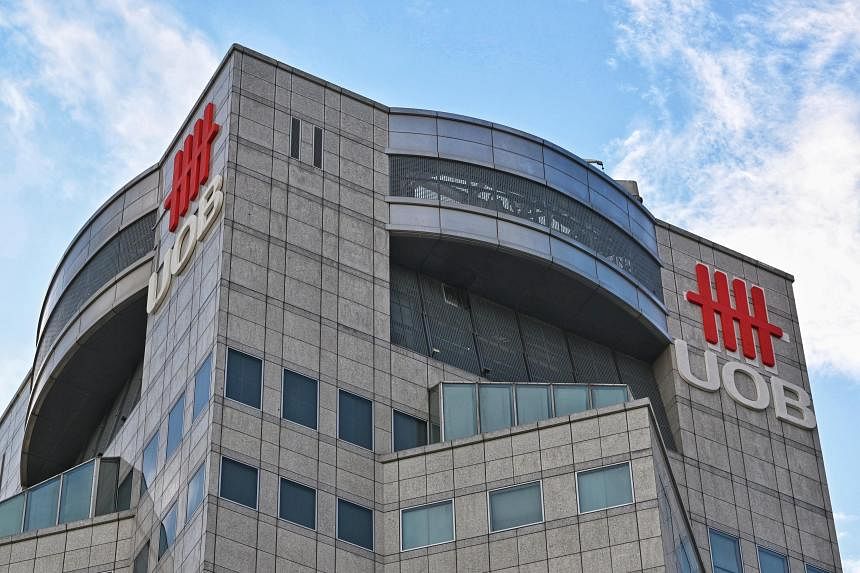SINGAPORE – UOB is expecting better loan and fee growth in 2024, saying that while the macroeconomic outlook is uncertain, the Asean region remains a bright spot.
Deputy chairman and chief executive Wee Ee Cheong projected mid single-digit loan growth and double-digit fee growth in 2024, versus low-to-mid single-digit loan growth and high single-digit fee growth for 2023.
He was briefing reporters following the release on Thursday of the bank’s third-quarter results, which showed that core net profit rose 5 per cent year on year to $1.48 billion, in line with Bloomberg forecasts.
However, including one-off expenses from UOB’s integration of Citigroup’s consumer businesses acquired in 2022, net profit for the quarter fell 1 per cent to $1.38 billion from $1.4 billion a year earlier.
This trailed the mean estimate of $1.46 billion from four analysts polled by financial data provider London Stock Exchange Group.
Mr Wee said that while the “macroeconomic environment could remain bumpy”, Asean’s fundamentals are still strong, with low unemployment rates and robust consumption.
UOB expects the region to post 4 per cent growth in 2023 and 4.9 per cent growth in 2024.
“Asean is also attracting more investment flows, especially in new economy sectors such as sustainability,” Mr Wee said, adding that another catalyst will come from the relocation of global supply chains to the region.
Besides growing market share in Asean, Mr Wee said: “We can capture other banks’ business, because we have the relationship and we have the platform.”
According to Mr Michael Makdad, senior equity analyst at Morningstar, UOB is more weighted towards Asean than its two rivals, DBS and OCBC, following its acquisition of Citigroup’s consumer businesses in 2022.
For the third quarter, Singapore’s third-largest bank saw net fee income rise 14 per cent year on year to $591 million, powered by higher credit card fees, wealth management fees and loan-related fees.
Credit card fee income crossed the $100 million mark for the first time, growing 89 per cent year on year to $104 million, as consumers continue to spend.
Mr Yeap Jun Rong, market analyst at online trading platform IG, said UOB’s robust growth in credit card fees was probably due to the Taylor Swift effect.
Fans of the American pop star rushed to sign up for the lender’s credit and debit cards in July to get ahead in the queue for tickets to her Singapore concerts. UOB is the official bank for the singer’s concerts in March 2024 and had reserved tickets for its cardholders. The surge in applications was across the bank’s markets in Singapore, Malaysia, Thailand, Indonesia and Vietnam.
Mr Yeap also noted that travel momentum has been largely intact, which boosted card fee income as well.
Mr Wee said fee income, such as wealth management fees and credit card fees, have become a key pillar for UOB, together with interest income.
“Five years ago, UOB depended a lot on loan growth. But today, given our investments to build our capabilities, fee income has become very important… We don’t just focus on one single loan (segment),” he said.
Mr Wee noted that the bank has invested $800 million over the past eight years to build its regional payments, trade and cash platforms. “We have started to see results and we are continuing to deepen our relationship with our clients,” he added.
Despite muted loan growth in the quarter, net interest income rose 9 per cent year on year to $2.4 billion, boosted by higher margins. UOB said it stayed disciplined and focused only on higher quality customers.
Net interest margin (Nim) was up 14 basis points to 2.09 per cent and UOB expects margins to remain at current levels in 2024.
Phillip Securities analyst Glenn Thum said that “Nim might not grow as fast or will just maintain at current levels” as UOB is trying to increase loan volumes.
The bank continues to place emphasis on home loans, with chief financial officer Lee Wai Fai saying that while new mortgage loans are slowing down, there is still activity in the refinancing of home loans.
Mr Lee said: “A lot of banks are lowering their two-year fixed and their three-year fixed mortgages... Mortgage continues to be an important asset class for us. We will compete to stay relevant.”
Mr Makdad thinks the mid single-digit (5 per cent) loan growth target for 2024 is attainable.
This is because the Citi acquisition and UOB’s greater weighting towards Asean instead of Hong Kong and Greater China, puts it in a better position to outperform other Asian banks on loan growth.
Meanwhile, the non-performing loan (NPL) ratio remained stable at 1.6 per cent and the balance sheet remained robust with healthy liquidity, said UOB.
The bank is guiding for credit cost at around 25 basis points to 30 basis points in 2024 compared with around 25 basis points for the rest of 2023.
Mr Yeap said it appears UOB is laying the groundwork for a further build-up in loan losses allowances.
Mr Thum added that the bank is taking a proactive approach even before loans become non-performing.
“These accounts still pay their interest on time. It is just because of the sectors and the region they are in (mainly Hong Kong, China and the United States),” he said.
UOB’s results kick off the third-quarter earnings season for local lenders. DBS Bank will report its numbers on Nov 6 and OCBC Bank on Nov 10.
UOB shares closed down 44 cents, or 1.6 per cent, at $27.28 on Thursday.
DBS shares slipped one cent, or 0.03 per cent, to $33.14 while OCBC edged up one cent, or 0.08 per cent, to $12.85.


